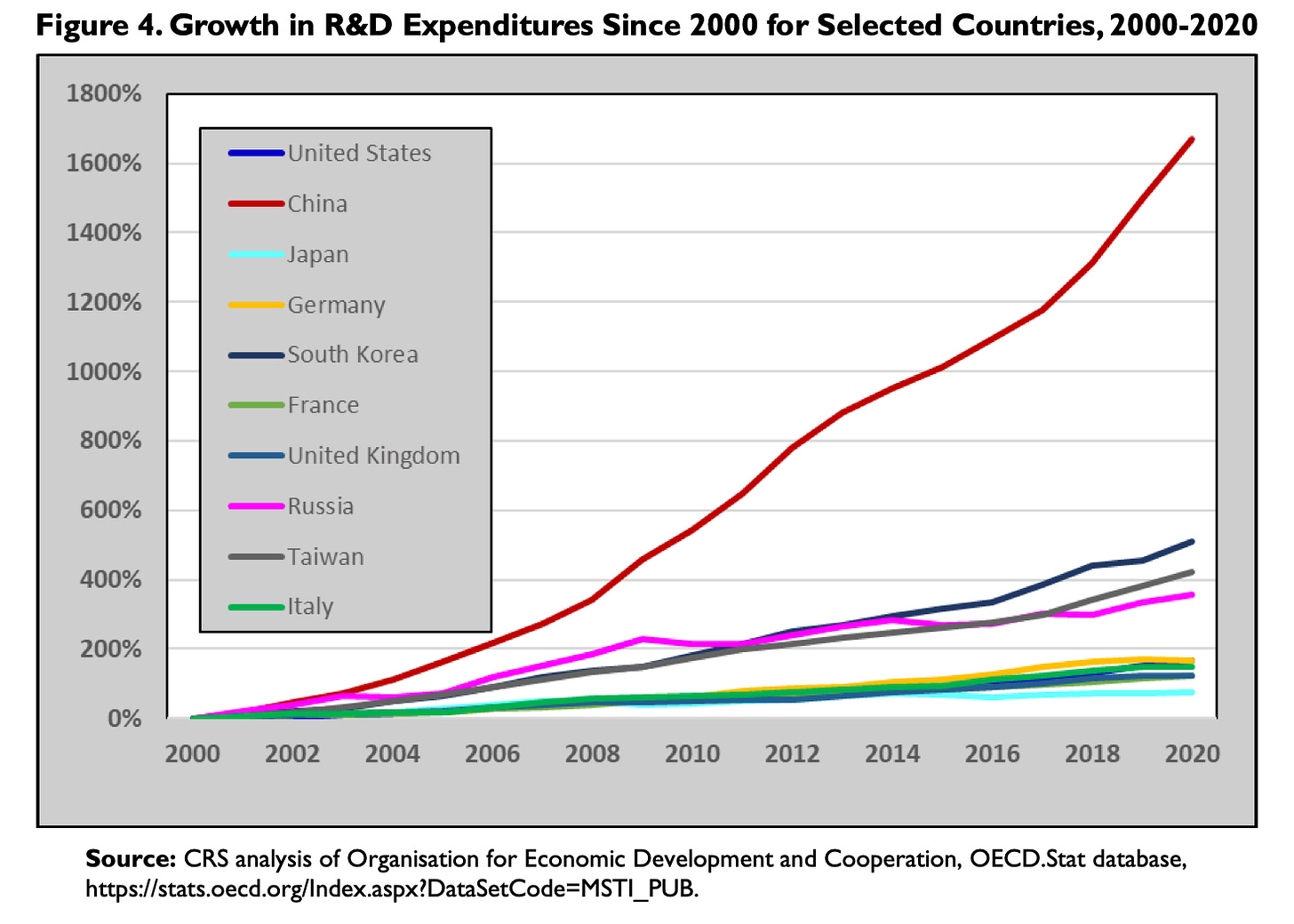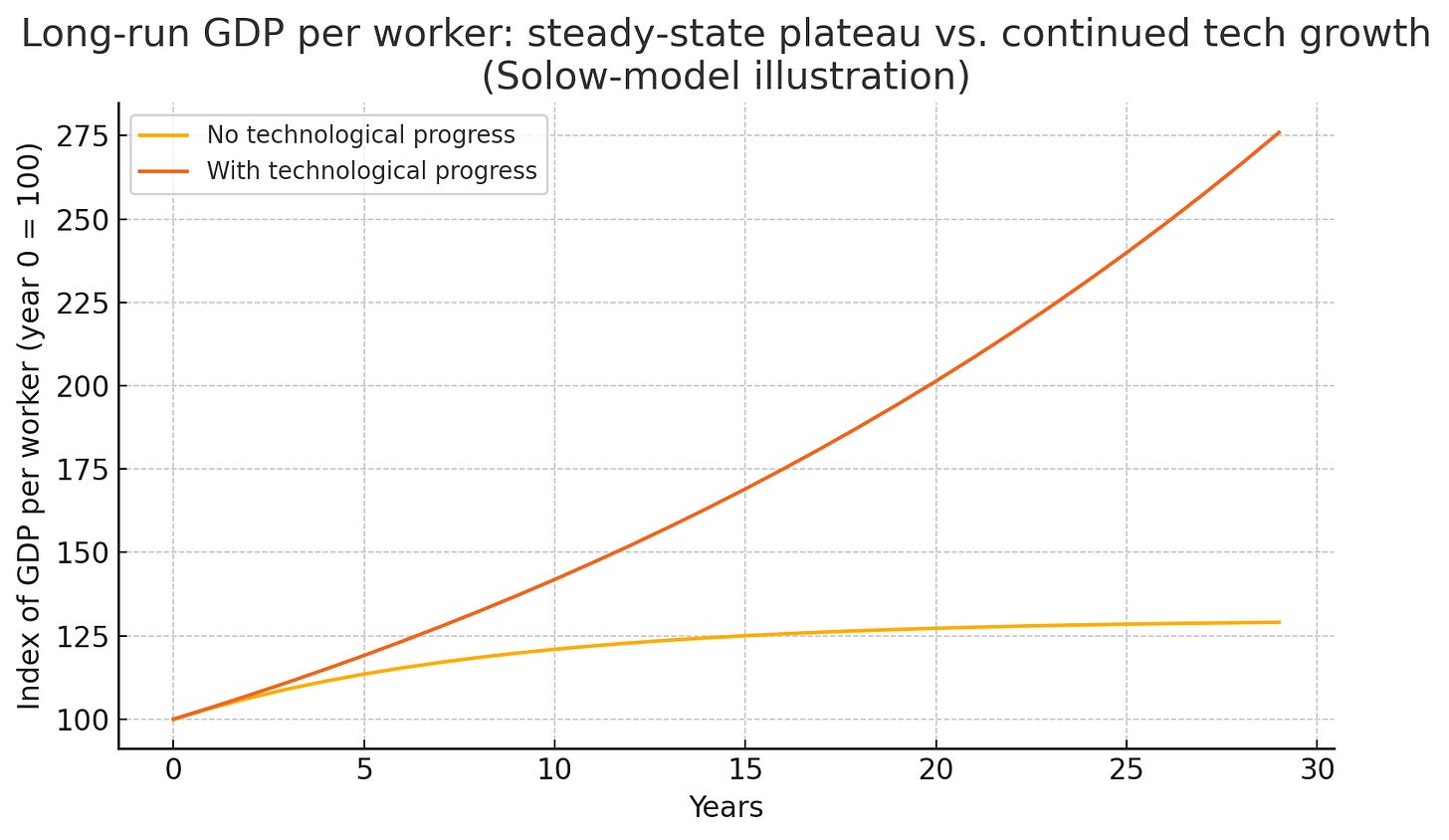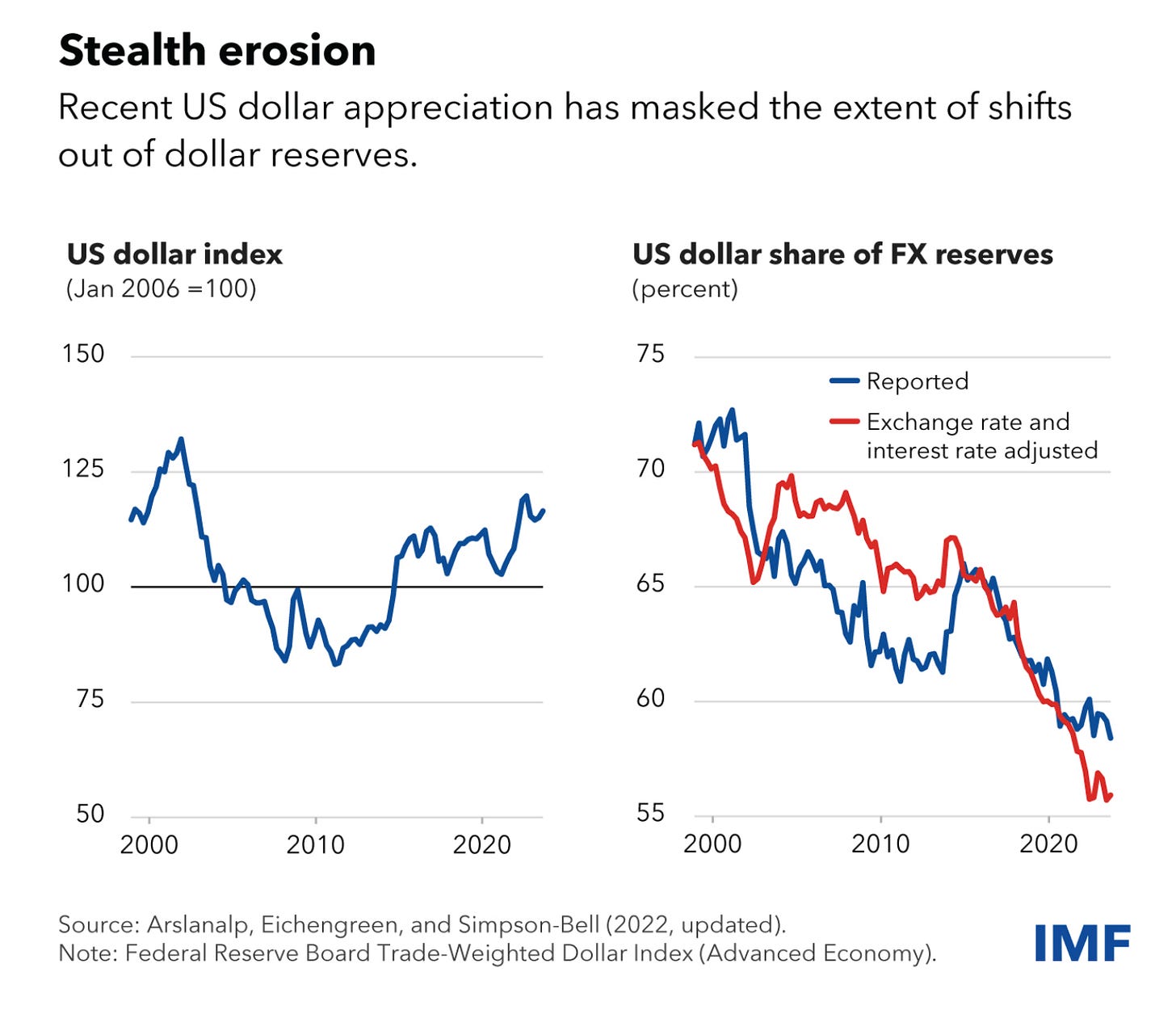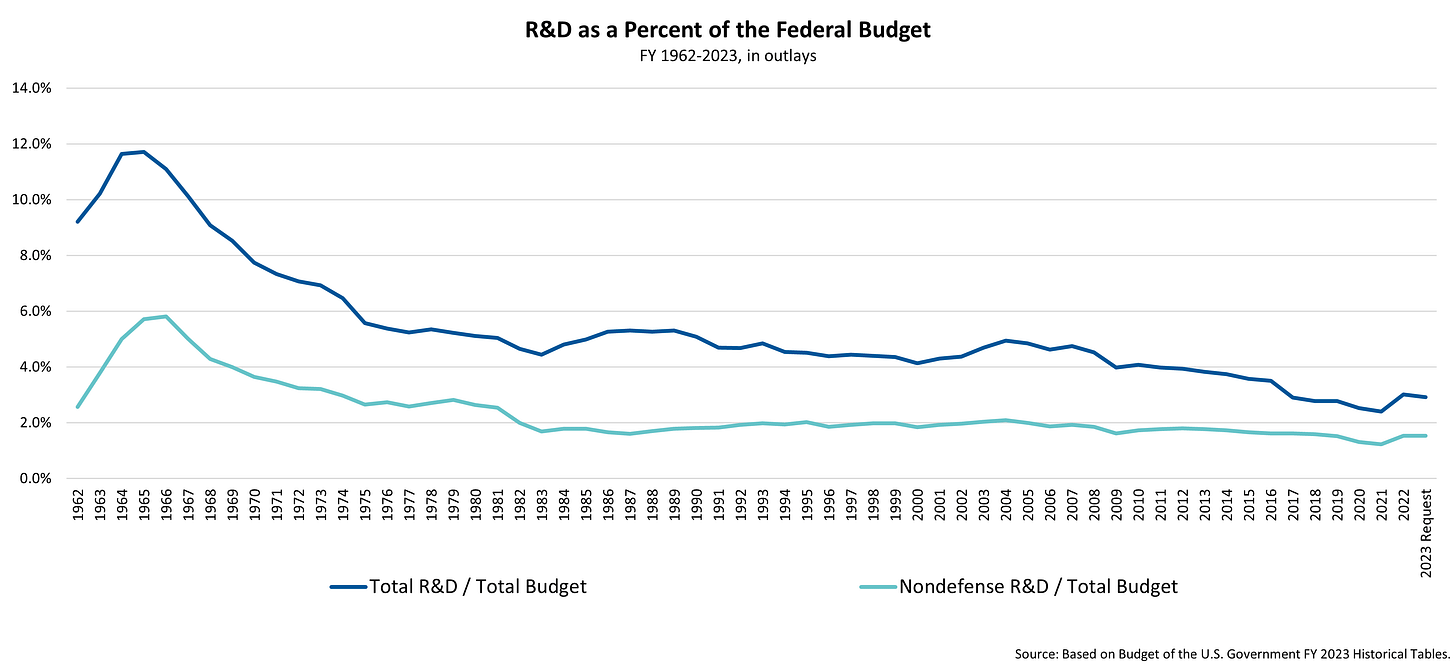Science funding was already way too low.
Restoring the status quo is not good enough; we should increase federal research funding to something like three times the previous level.
Cutting federal research funding is extremely short-sighted, but the previous funding levels were also short-sighted. I think those previous levels were off by something like 3x. There are so many compelling and synergistic justifications as to why, that it can be overwhelming to reason (and write!) about. So, in this post, I’m going to list ten justifications out at a high level, and plan to explore more nuance in the future.
Justifications for increasing federal research funding
1. Longevity
Do you want your family members to live over 100? I assume so, but U.S. life expectancy is about 80 today. Where do you think the biomedical breakthroughs we need to increase it will come from? For example, Sickle Cell disease is now being cured in some patients via CRISPR gene editing. NIH grants were critical to this work, and that’s true for most transformational drugs. These types of cures can’t come fast enough; increasing research funding is the way to get them even quicker.
2. Defense
From my essay, The Great Race:
One or more key future technologies, such as artificial superintelligence, quantum computing, humanoid robots, space tech, etc., will likely afford the leader a significant military advantage. What if China becomes years ahead of us in all these critical technologies? Let it sink in that this is what we were to China just a few decades ago.
Falling behind on R&D today risks losing real wars tomorrow, and we’re already well on the path to falling behind China in particular. China has aggressively grown their R&D expenditures, 17× from 2000-2020 and now nearing U.S. aggregate levels, while U.S. federal R&D has crawled. We need to invest enough to keep ahead of China, and that’s more than we do today. Empirically, non-governmental funding isn’t keeping pace alone.
3. Returns
Science funding is one of, if not the best, dollar-for-dollar investments a country can make. I will do a deeper dive on this, though check out this Science|Business report that seems to have done a relatively thorough meta-analysis on academic studies looking into this question, concluding:
The many economic measurements of returns on investment to publicly funded R&I [Research & Innovation] vary wildly in range, but seem to cluster at around a 20% annual [social] return on investment.
That’s a higher rate of return than the stock market, and from the federal government’s perspective, it’s a significantly higher return relative to other federal investments available at scale. For example, returns on universal Pre-K are estimated to be more in the 10% range (I happen to think we should do that too, but science funding is even more critical).
If you believe the government should invest some of its money in the best investments for the country it has available, then science funding is a contender for #1. We should keep putting money into this investment until we reach diminishing returns, which we are nowhere near today.
In fact, the returns are so high that, under reasonable assumptions (for example, real Treasury rate ~3 %, about one-fifth of each extra dollar of GDP showing up as federal revenue, five-year gestation period, etc.), in the long run this investment will actually decrease our debt-to-GDP ratio (via an increased tax base). From the IMF’s April 2024 IMF Fiscal Monitor that ran such a scenario (emphasis added):
The innovation policy mix also lowers the public-debt-to-GDP ratio by about 0.5 percentage point over an eight-year horizon, as the initial increase in debt from higher fiscal spending is gradually offset by higher GDP and revenue (Online Annex 2.5)
Science funding isn’t an expense, it’s an investment with high returns!
4. Prosperity
Funding science pays for itself because scientific breakthroughs are the hidden force that grows our economy. In fact, without new technology, our economic prosperity is fundamentally limited. To see that, suppose no breakthroughs occur from this moment onward; we get no new technology based on no new science. Once we max out the hours we can work, the education people will seek, and the efficiency with existing technology, then what? We’d be literally stuck. Fundamentally, if you don’t have new tools, new technology, new scientific breakthroughs, you stagnate.
From my essay:
Think of how worker productivity increased in construction with the introduction of power tools and heavy machinery or in offices with the introduction of computers and the Internet. We need more of these, many times over: true leaps forward in technology applications that will dramatically increase our worker productivity.
This productivity increase means increasing output per hour worked (by definition), and therefore GDP (assuming hours are constant). If the U.S. had grown just one percent faster over the past fifty years, our average income (real GDP per capita) would be ~66% higher today. Research-driven productivity improvement is one of the few policy levers big enough to recreate that missed windfall, and more of it is better.
5. Innovation
Technological breakthroughs also mean better everyday products, so we get a higher standard of living for the same dollar output because we’re getting better, more innovative stuff to consume. Think of better household appliances, or in the future, self-driving cars vs. regular cars. Such innovations reduce household chores and costs, making our leisure time more enjoyable and giving us more of it. By increasing research funding, we’re buying future life satisfaction, and again, the more of that, the better.
6. Resilience
Will we have the science to respond to unexpected calamities, like new pandemics, asteroids, resistant antibiotics, etc.? Robust pathogen surveillance, AI-designed antibiotics, planetary-defense tech, and the like are insurance policies we aren’t buying enough of today. For example, we spend about 200M on antibiotic resistance, which already costs us $4.6 billion annually, let alone what that would balloon to if we had a severe, uncontrollable outbreak.
7. Jobs
As I noted above, research funding is a great investment long-term. It’s also a jobs engine in the short term. For example, this report from the nonprofit United for Medical Research found, with regards to NIH funding in particular (emphasis added):
As NIH funding is awarded to researchers in individual states, that funding supports employment and the purchase of research-related goods, services and materials. The income generated from these operational expenditures, along with that from capital asset expenditures (e.g., building, equipment, machinery, sophisticated software) cycles through the economy to produce new economic activity.
In 2022, that funding supported an average of 2,300 jobs and $353 million in new economic activity per state, or $2.3 dollars of economic activity for each dollar of NIH research funding.
More generally, research funding is a jobs win in three ways: First, you fund great jobs directly, today. Second, those jobs also fund supporting jobs today, as in the example. Third, the actual research creates better future jobs that will utilize the new technology being developed. Can we ever upgrade our jobs too much?
8. Frontier
Are we really going to cede the physical frontier, like Mars and the Moon, and the virtual frontier, like AI and the metaverse, to other countries? I hope not. We will need to spend more to win these races. What happened to the American frontier spirit?
9. Sovereignty
Maybe you don’t care about the physical or virtual frontier, fine. But what about ensuring critical technologies for our current infrastructure can be made in the U.S., like those that go into making semiconductors and energy. If we don’t stay at the forefront of these essential components, we risk being held hostage by other countries and at least partially losing our economic sovereignty, which has arguably already happened. From a 2023 report by the U.S. International Trade Commission:
Around 92 percent of the world’s most advanced chip manufacturing capacity is located in Taiwan. Any disruptions to Taiwan semiconductor manufacturing—whether caused by pandemics, natural disasters such as typhoons or earthquakes, power or water shortages, factory shutdowns, or international conflict—would potentially have large impacts on global semiconductor supply.
10. Environment
Similarly, we need new research to manage climate change effectively without throttling growth, such as in cheap energy storage and scaling carbon removal technologies. From the IPCC 2023 report:
Carbon dioxide removal (CDR) will be necessary to achieve net negative CO2 emissions. [CDR Fact Sheet]
Or, if you are more generally concerned about using up the Earth’s resources or other environmental impacts, it’s the same story. Increasing research funding means limiting more ecological damage by finding ways to be more energy efficient and finding less damaging energy pathways.
11. Power
Technological leadership buys global leverage. If you are technologically dominant, built on the back of research funding, everyone wants to trade with you for your superior technology and invest with you to get those returns mentioned above. Put differently: the more the world needs the next generation of U.S. chips, biomedicine, and clean-tech, the more it requires dollars to trade for them.
If we lose that leadership, however, in the worst case, we also lose all the soft power that comes with it, including being the world’s reserve currency. According to this 2024 IMF bulletin, this has already been happening for the last 25 years:
Again, from my essay:
We believe our ability to control inflation and interest rates is inadequate now—most other countries have much less control. Given our dominance, what we do has an enormous knock-on effect on their currencies. If the yuan becomes the dominant currency, we will experience similar knock-on effects from China’s actions, not vice versa.
I know, I know, I said 10 justifications, and I did 11…
Sold, but how much should we increase science funding?
The above essentially says in eleven different ways that more science funding is better, but doesn’t answer the question of how much more. How would we know when we reached an optimal level? I’m not sure exactly, but I’m positive the optimal level is much higher than it is now.
This post is already longish, so I’ll save details on that for another day, but here are two back-of-the-envelope swings that essentially get to the same place: something like 3x from where we were (before any recent cuts).
First, looking at it from the perspective of adequately matching China, which I explore more fully in my previously referenced essay:
To provide context, in 2022, total U.S. R&D investment reached approximately $900 billion, with China trailing closely behind. The federal government accounted for about $150 billion of this total. In the short term, the total U.S. R&D investment should at least double to more than $2 trillion, to more than double China’s investment. Suppose we assume half of this ~$1 trillion increase comes directly from the federal government and half from industry (matching/following government incentives/investment). In that case, we must allocate ~$500 billion more annually in federal R&D investment today.
Second, that result is approximately equal to how much we allocated in the Space Race, the last time we tried to invest in science on a large scale. At that time. Federal R&D as a % of the federal budget averaged around 10%, which again is about 3x more than today:
Of course, reaching that amount will require many new and innovative policy programs. I’ll post on that, too, in the future, but in the meantime, comments are welcome to further the conversation (and my thinking) and correct any errors. Finally, this scene from the movie Roxanne inspired me to write this post in this format.







I enjoyed this. Compared to government R&D investments in other countries, we seem to get much better returns in the U.S. After 15 years working in philanthropy, I’ve seen how impact gets diluted when funding ramps up. We see it in frothy investment markets too. Curious for your take on how to maintain high ROI if you triple government spending on R&D. With 3x more investment, should we expect 2x more return? Less?